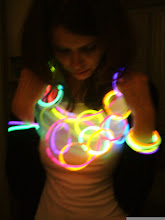 Picture this: a peasant woman from an unnamed East European state is dancing in full ancient ceremonial garments in front of a backdrop of a painting of a beautiful meadow somewhere in central Europe. But the music isn't an obscure East European folk dance, it's Beyonce's "Single Ladies" (Put a ring on it), blaring, at top volume. See it here - http://www.youtube.com/user/GeryGeorgieva
Picture this: a peasant woman from an unnamed East European state is dancing in full ancient ceremonial garments in front of a backdrop of a painting of a beautiful meadow somewhere in central Europe. But the music isn't an obscure East European folk dance, it's Beyonce's "Single Ladies" (Put a ring on it), blaring, at top volume. See it here - http://www.youtube.com/user/GeryGeorgievaAnd I watch the dancer she is doing all the exact moves of the famous Beyonce video we all know so well. But because she is dressed like a simple traditional girl and features in this context suddenly the dance seems to reveal itself as, well exactly what it is: thigh-slapping, finger wagging little song of a plucky peasant girl from the village green.


It's brilliant how this makes me question all the supposedly cool and up to the minute representations we scan everyday. We look down on so-called peasants from the past, or even on immigrants or refugees from Eastern Europe who we secretly deride as being out-of-date, or who do not understand our culture, but we are all watching some dressed up girl in a posh fashion costume from America, the land of the future, do a typical seduction / wooing dance from way back. So who is so culturally superior now?
The video is the work of performance artist Gergana Georgieva - featured as part of Goldsmiths College final year show 2009. Like Gillian Wearing she uses video work to question identity skilfully and originally. But her work has more universal themes connected to the identity of outsiders from other cultures and our prejudices and assumptions towards them.
 In another video, she creates skin-coloured full face rigid masks, worn by two supposed foreigners, who are answering facile questions from a rather glib off-camera reporter. The immigrants have no lips because of their masks and seem to speak but say no actual words - we simply have subtitles to represent them. Particularly funny is when the naive reporter asks them about having a sense of humour. The masks and subtitles simply cannot communicate. The scene is comical but it seems it is the reporter who looks more the idiot with her constant nonsensical questions.
In another video, she creates skin-coloured full face rigid masks, worn by two supposed foreigners, who are answering facile questions from a rather glib off-camera reporter. The immigrants have no lips because of their masks and seem to speak but say no actual words - we simply have subtitles to represent them. Particularly funny is when the naive reporter asks them about having a sense of humour. The masks and subtitles simply cannot communicate. The scene is comical but it seems it is the reporter who looks more the idiot with her constant nonsensical questions.Some of the best art I have seen recently re-ignites a purpose of art as a way to question our safe and narcissisitic enclosed view of the world, questioning comfortable assumptions that are shared by many in Western European societies. The Vidarbha cotton widows (http://www.vidarbha-project.com/) book, film and stills project by Verena Hanschke at the RCA similarly shines a wincingly bright flashlight at Monsanto and the disaster genetically modified crops are having on indian farmers. Reminiscent of Taryn Simon's "Innocents" work, Verena Hanschke, brings to life the widows of the hundreds of farmers who have desperately taken their own lives in despair as they lose everything. But the light she shines is not depressing but penetrating and beautiful...


 I am a fan of
I am a fan of 




